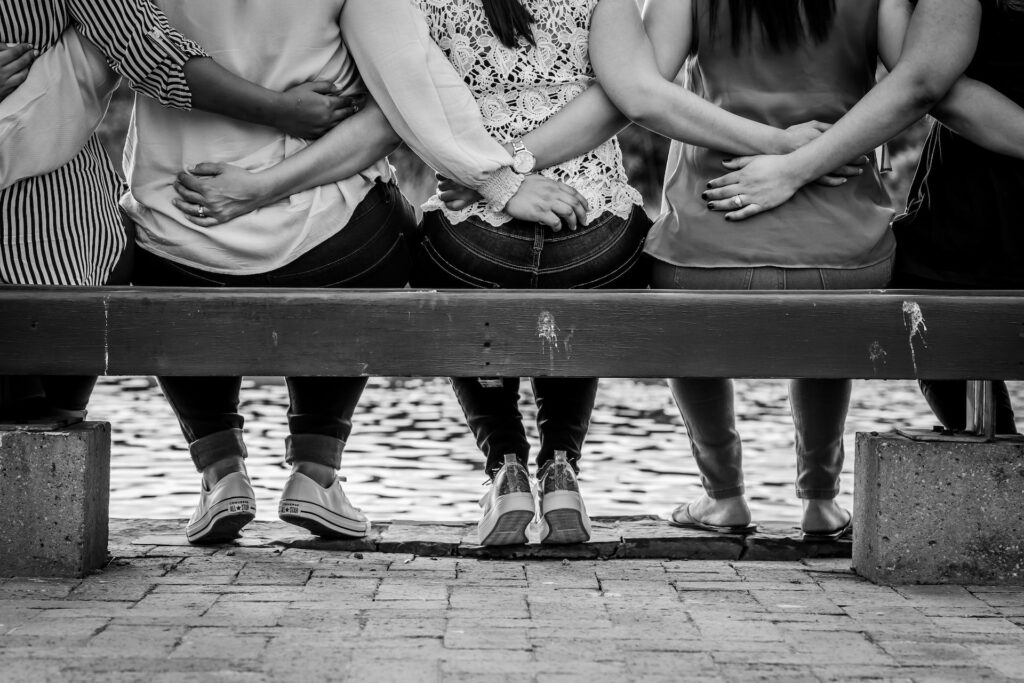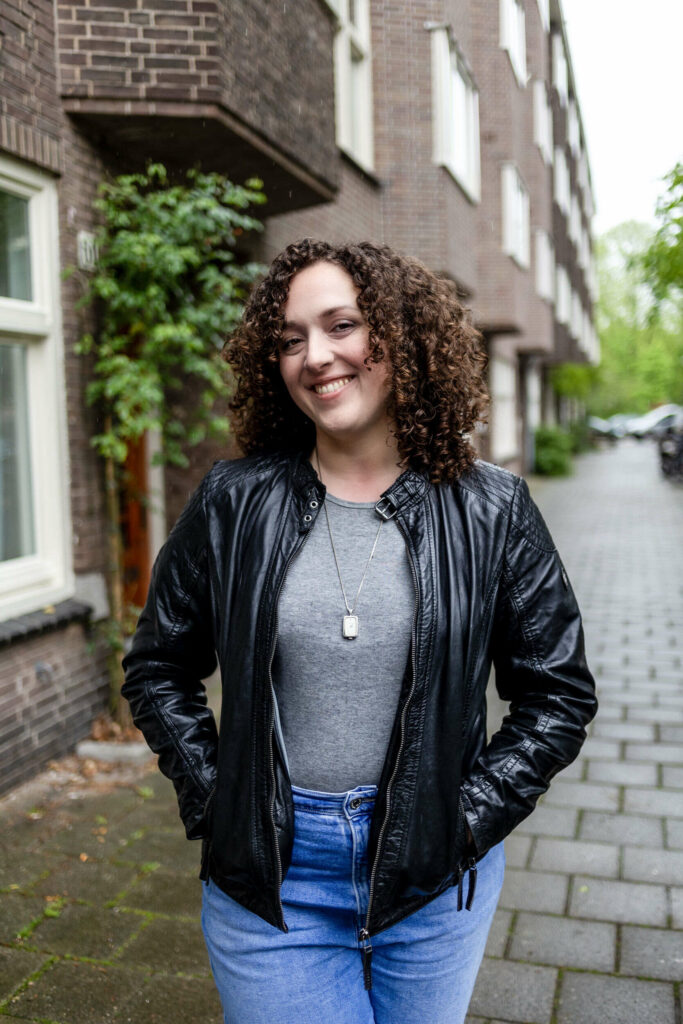Since the 1990s, war has repeatedly broken out between Armenia and Azerbaijan, most recently again in the Nagorno-Karabakh enclave. The focus of reporting is on political analysis and power struggles between – more often than not – men. However, the effect that crises and conflicts have on women is too rarely seen.

by Sarah Tekath
The truck lurches down the dirt road. The driver steers carefully through the many potholes, only driving at a walking pace. Behind him are three more cars. The convoy wants to deliver a washing machine. Their destination? A group of refugees from the Karabakh region who have found shelter in Masis, a town with a population of just under 20,000, 15 kilometers from the capital Yerevan. Until now, they had to wash by hand.
At the end of the street, a wide open space unfolds, with a house on the left. A group of women stands in front of it, with numerous children around them.
Men jump out of the cars. Within seconds they have surrounded the women. They are talking loudly to each other, all running around frantically. Several are pushing the handcart with the washing machine, someone is filming the action with a smartphone, and another is recording sounds.
The women stand silently in the chaos and watch. No one speaks to them or pays them any attention. A moment that is almost symbolic of the situation of women in conflict.
Thinking about the common good
In 2023, the situation in Karabakh escalated once again. Ilham Aliyev, President of Azerbaijan, had already imposed a blockade on the region at the beginning of the year, followed by a military attack in the fall. More than 100,000 people were forced to flee.
Among them are these women in Masis, who have retreated from their homes to escape the turmoil. They don’t want to read their names in the newspaper. Nor do they want to tell what happened to them. When the translator starts to explain what it’s all about, one of the women immediately leaves the room in tears.
Later, she comes back to tell that her husband was recently killed in the war for Karabakh. Now she is alone with ten children.
One of the older women is her mother, and the other is her mother-in-law. The latter tearfully shares that she has already lost two sons in the conflict. Their photos hang framed on the bare wall.
A total of 22 people live in the sparse dwelling. The windows do not close properly, the roof leaks, and there are not enough beds for everyone. They sleep on the floor.
During the conversation, the women repeatedly apologize for not being able to offer anything apart from water and coffee. In their home, they say, they would have loaded the entire table with food in such a case.
When asked what they wish for and what they need, they answer collectively: proper beds, new windows, a better kitchen, a better insulation for the upcoming winter.
Raised to be selfless
This behavior does not surprise Liza Matevosyan, director of the “Women’s Center. Shushi” NGO. The activist came to Yerevan in 2020 as a refugee from the war in her home region. But even in the Armenian capital, the war is catching up to her.
She arrives 30 minutes late for the interview, coming straight from a funeral. Her uncle was injured in the explosion of a petrol tank in September and died a few days ago. She wants to do the interview anyway.
“In Armenian society, it is always their husband, their family, their children, everyone except them. Women are never the priority. Not even to themselves,” she explains. “These forcefully displaced women have no choice but to carry on. They don‘t allow themselves to accept the grief or trauma because if they fall apart they won’t be able to support their children.”
Conflicts fuel violence against women
But the trauma goes beyond individual pain and loss. Ani Jilozian from the “Women’s Support Center” organization knows that the conflict has had a profound impact on Armenian society, causing problems and risks for women.
“We’ve observed a 20% uptick since 2020. Since Covid, the war, the ongoing conflict and instability, which of course exacerbate the issue of domestic violence, we’ve seen a pretty strong increase in the number of case referrals,” Jilozian explains. As does military service. “The most dangerous perpetrators are those impacted by the conflicts. So there’s that link between domestic violence and experiences related to political violence or turmoil,” Jilozian continues. “And I believe that link exists everywhere in the world where there is conflict or warfare.”
However, the suffering of women is not heard in society. There is too much respect for the soldiers.
“We’ve seen that many women are unwilling to end this cycle of violence because they see that their husbands were traumatized by war. They accept the violence in their homes as some sort of consequence of that trauma,” Jilozian notes. “Their perception is that their husbands served the country, returned and they need to stick around basically to support their husbands and their loved ones.”
This spiral of domestic violence also affects future generations. “Children who witness violence are often just as traumatized as those experiencing violence. We call it a cycle of violence. We’ve noticed that the children who witness abuse, seeing their father as the perpetrator or their mother as the victim, often replay those same roles in their future relationships,” Jilozian elaborates.
Women’s bodies as national property
While the violence of Armenian men against Armenian women is legitimized through war heroism, an idea of their bodies as national property is developing at the same time, Matevosyan says.
“In our society, we have this violence against women, but we have another culture where we see women as sacred. No one can touch them. Especially no Azerbaijani man.” This is also how girls and women are brought up, according to the activist. “He’s the enemy and he can‘t touch you. This places even greater pressure on women.”
The claims to ownership of female bodies also have an impact on abortion rights. “Sex-selective abortion is a major issue in Armenia. We have some of the highest sex-selective abortion rates in the world per capita. Moreover, following substantial losses in war, there is an emerging rhetoric of the need for more boys to protect the homeland,” says Zaruhi Hovhannisyan from Women’s Support Center.
She recalls that during the last war in 2020, when feminists brought this issue into the public eye, they were met with a lot of hatred. “Instead of focusing on the issue of ending war and conflicts, they were focused on the topic of abortion,” Hovhannisyan says. “This approach reduced women’s bodies to mere tools for producing boys.”
However, the activists also notice this dynamic in general when it comes to feminist concerns in a conflict. They have often been told to take care of the ‘real’ problems like the war, rather than private family matters.
“Women’s rights are always sidelined when you’re in a country that experiences war and ongoing conflict because it’s just not seen as an important issue,” Jilozian emphasizes.
In Karabakh, during the months of the blockade, there were further risks for women. For example, there was an increase in the number of miscarriages due to a lack of gasoline or access to the health system, she explains.
“The absence of prenatal and post-natal services results in excessive bleeding, miscarriages or stillbirths. Not to mention malnutrition, which was a huge problem due to the blockade and the forceful displacement,” Jilozian says. “We know from personal testimonies that with limited food available women were trying as best as possible to distribute it to the children and the elderly in their families often neglecting their own needs.”
Patriarchy on both sides
Sevinj Samadzade is the founder of the Feminist Peace Collective (FPC). The activist grew up in Azerbaijan, in a town near the border with Georgia and Armenia, and founded the organization after the Karabakh War in 2020 to create an exchange of feminist perspectives on the conflict. Their website is now blocked in Azerbaijan.
“War and the ongoing perpetual violence affect the general understanding of violence in the society, normalizing it.”
However, according to Samadzade, patriarchal violence against women was already a problem in both Armenia and Azerbaijan. “Before the 2020 war, violence against women was already quite high in these countries and also in Karabakh. Some people argue that this is related to the first Karabakh war because of this very violent and nationalist state-building process. During this phase the gender roles in Armenia and Azerbaijan became so much in dichotomy, and patriarchal states needed these rules to be strengthened.”
Governments further consolidate this by propagating anti-abortion and anti-feminism. Just as in Armenia, the idea that women should give birth to soldiers applies in Azerbaijan.
The activist also explains that violence against women is now a normalized part of pop culture. “You can see it in media that these narratives are reinforced. They offer justifications for men using violence. We can see also that modern soap operas, movies, and TV programs in Azerbaijan and Armenia support these narratives.”
According to Samadzade, women in Azerbaijan have no political power.
This is similarly observed in Armenia as well. “We have in place a 30% quota system for women involved in politics, yet in reality, they don’t hold the highest levels of decision-making power. And what ends up happening is you have something that looks good on paper, but it’s not implemented in practice. This scenario involves women being elected but later stepping down from their positions, which are then assumed by men. Thus, this 30% quota has never really been achieved,” Jilozian says.
Uniting feminist forces
Samadzade sees women on both sides of the conflict in identical circumstances. “I believe women in both countries are stuck in the same situation. The younger generation of women in Armenia and Azerbaijan didn’t have any chance of communication because they were so separated from each other since the 90s. They think they have very different contexts but once they come together, once they share stories, they realize that their stories just complete each other.”
For this reason, the Feminist Peace Collective has launched its own #MeToo campaign for the South Caucasus, inviting women to tell their stories – without revealing their origins. “When you read the stories you don’t know where they come from because there are just similar contexts. And I think this kind of similarities -shared encounters of similar violence and exchange of comparable pain – create a connection between the women of Armenia and Azerbaijan, which is more impactful than the division caused by the war.”
That is why this war must finally become political from a feminist perspective, she believes.
“I think this is the moment for the women of Azerbaijan and Armenia to make their grief and pain political because so far they think it’s personal or cultural. But it is not. We have to unite, across borders, against the patriarchy.”
This article was published within the frames of “Correspondents in Conflict” Project,
implemented by Yerevan Press Club and Deutsche Gesellschaft e. V. The Project is
funded by the German Federal Foreign Office within the “Eastern Partnership Program”.
The contents of this article are the sole responsibility of the implementing partners and can in
no way be taken to reflect the views of the Federal Foreign Office. #civilsocietycooperation
Sarah Tekath is a freelance journalist, podcaster and foreign correspondent in Amsterdam. She works for several German and international media, such as Deine Korrespondentin, Perspective Daily and Deutschlandfunk. In her reports, she mainly focuses on queer rights, feminism and social issues.













